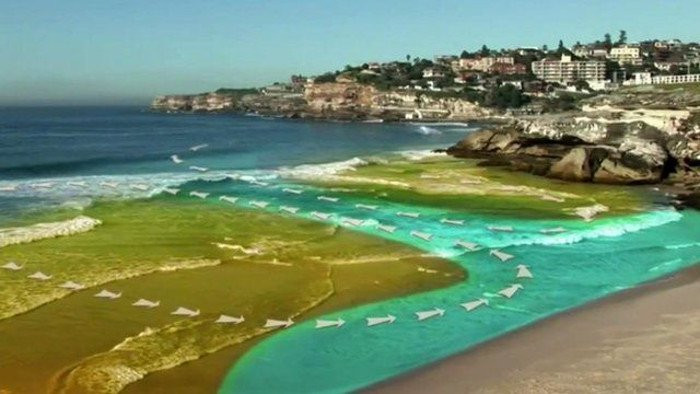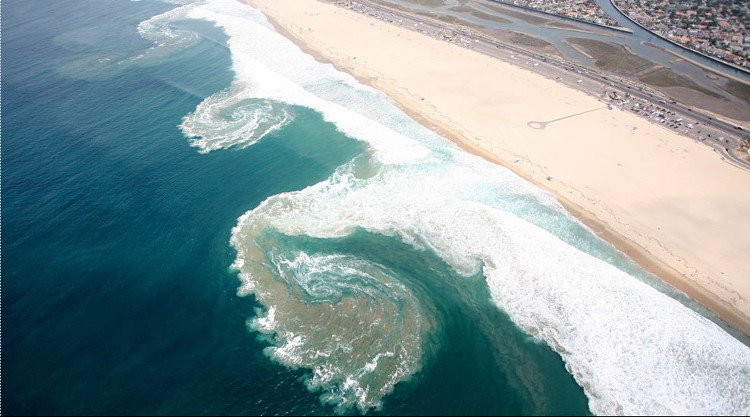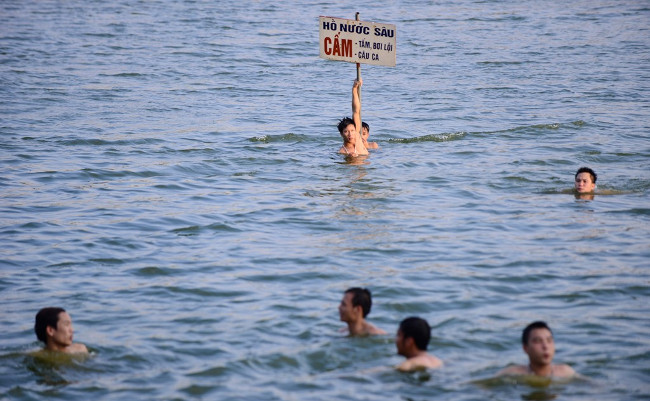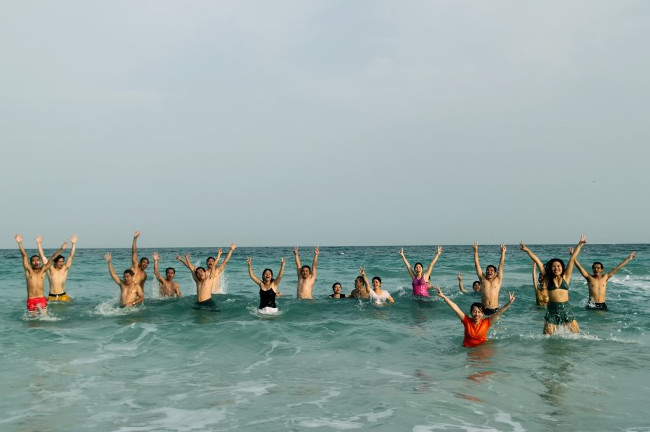Memorize these 8 tips before going swimming to ensure your safety
Drowning accidents in the sea, rivers and lakes are the cause of millions of deaths every year worldwide. To prepare for a happy, safe summer, avoid unfortunate accidents, you need to remember 8 notes after bathing in the sea, rivers and lakes.
1. Warm up the body before getting into the water
The first rule that everyone needs to comply with before going to the water is to perform movements to activate joints and muscles to help us avoid cramps while in the water.

You should not exercise too much but just do morning exercises or run short distances of about 100m. After that, you should descend into the water slowly so that your body has time to adjust due to the ambient temperature and the difference in the water.
2. When bathing in the sea, it is necessary to observe and prevent the outflow of water and whirlpools

When taking a bath at any beach, you should spend about 5-10 minutes to observe the danger signs and identify the offshore flow.
Offshore currents are strong currents of water flowing from the shore towards the sea. The offshore flow is likened to a small river, formed when waves hit and brought sea water continuously to the shore, they gathered into a stream that swept all that fell into it far from the shore.
To avoid falling into areas with offshore currents, you should pay attention to:
- Quiet waters, almost no waves often appear far off shore.
- Which waters are darker, where the water is deeper.
- Do not move near areas where debris / bubbles appear on the surface of the offshore flow and float into the sea.

The whirlpool is formed because this wave spills into the previous wave position, causing rotation. Meanwhile, it will move the sand in the seabed to another place and create a deep pool.
You should stay away from the whirlpool area because if you fall into that area, the vortices will grab and pull you straight to the bottom.
If you get caught up in the whirlpool, you need to calm down and let the whirlpool take you outside, then swim to the shore.
3. Do not swim too far from the shore, pay attention to dangerous warning signs

In remote waters, you will face big waves and unexpected risks that are hard to anticipate.
The advice for you is that you should not stay more than 15m away from the shore, in an area more than 5m deep so that if something goes wrong, the relief team members can quickly move to support and emergency.
In the rivers, lakes and areas of deep sea water, with whirlpools, all of them are marked with dangerous signs and banned from bathing. You should carefully observe and follow this sign.
4. Do not shower on the big wave
Before going to the beach, you should see the weather forecast to master the weather information on the sea that day. This will help you know whether or not you should swim.
You should not go to the beach on days with high winds, big waves or storms. If you find that the sea is unusually quiet, the water recedes or there are many flocks of flying birds, you should quickly go to shore and find a high place to shelter.
5. No swimming, bathing near cliffs, jetties, pillars
Cliffs, wharves . are places where the waves are quite strong and this is also the shelter of many mollusks that can attack you. Therefore, you should stay away from these areas to ensure safety, avoid unexpected accidents.
6. Never go swimming alone

When taking a bath or swimming, you should not go alone, so choose a crowded place to support each other when an incident occurs.
7. When problems occur, calm down
If something goes wrong, you need to be really calm to handle:
- Holding her breath, closing her mouth, relaxing her body so that her lungs do not choke water but gradually rise.
- Using your hands and feet to make a paddle, water fans push your head up out of the water and wait for people to save.
- You can take advantage of the flow to swim into the shallower, move to the shore if you swim well.
8. Health attention before entering the country
The sunshine in the sea is quite strong, so you should not sunbathe too long before going into the water to avoid sunstroke, cold.
Immediately ashore when there are the following symptoms: dizziness, nausea, difficulty breathing, fatigue .
- Smoke - The killer killed invisible in fires
- How to effectively prevent car sickness without taking medicine
- What to do to escape when being laid down in quicksand?
You should read it
- Scientifically proven: Swimming helps the brain stay healthy and reduce stress, fatigue
- 10 reasons you should sign up for a swimming course this summer
- Get water into your ear after swimming properly according to expert's instructions
- Integrated swimming quality monitoring set in glass
- 11 fastest swimming fish in the world
- Corel Draw 12: Draw the ducklings swimming
- The dramatic swimming competition of 300 million sperm comes to see eggs under a humorous perspective
- Detecting an asteroid the size of an olympic swimming pool, topping the list of Earth collision risk
May be interested
- Integrated swimming quality monitoring set in glass
 the edge device uses a biosensor to monitor over 30 swimming indicators during training. they include indicators like distance traveled, calories burned, heart rate, breathing ...
the edge device uses a biosensor to monitor over 30 swimming indicators during training. they include indicators like distance traveled, calories burned, heart rate, breathing ... - 11 fastest swimming fish in the world
 the following fish species with slim body and special skin structure, have amazingly fast swimming speed.
the following fish species with slim body and special skin structure, have amazingly fast swimming speed. - Why is the thermos flask so fast? How to use the bottle for safety?
 in this article, quantrimang will explain why your family's thermos break down quickly, and in particular you will know how to use the bottle to prolong life and ensure safety. let's follow it.
in this article, quantrimang will explain why your family's thermos break down quickly, and in particular you will know how to use the bottle to prolong life and ensure safety. let's follow it. - Great way to remember 90% of what you learn
 learning to memorize more information, we can take less time to re-learn and focus on new knowledge. time still goes by and the question is: how will we use it most effectively?
learning to memorize more information, we can take less time to re-learn and focus on new knowledge. time still goes by and the question is: how will we use it most effectively? - What is Twitter's new Safety Mode? How does Safety Mode work?
 over the years, many twitter users have felt unsafe with various types of unwanted interactions, from stalking to annoying harassment. twitter is trying to make these unpleasant experiences a thing of the past with the new safety mode feature.
over the years, many twitter users have felt unsafe with various types of unwanted interactions, from stalking to annoying harassment. twitter is trying to make these unpleasant experiences a thing of the past with the new safety mode feature. - Principles for traveling on the road to ensure safety in stormy days
 holding on to these tips will help you to be safer when forced to move during a stormy day.
holding on to these tips will help you to be safer when forced to move during a stormy day. - Multiple choice questions about network safety deployment have the answer P1
 below network administrator will send you multiple choice questions around the topic of network security. network security is a broad topic, full of knowledge, so the following questions will help you add many useful things.
below network administrator will send you multiple choice questions around the topic of network security. network security is a broad topic, full of knowledge, so the following questions will help you add many useful things. - Corel Draw 12: Draw the ducklings swimming
 step 1: draw the swimming duck shape - select the bezier tool to draw the shape of the swimming duck - draw the tail, wings, eyes and beak parts of the duck. for the eyes part, use the ellipse drawing tool.
step 1: draw the swimming duck shape - select the bezier tool to draw the shape of the swimming duck - draw the tail, wings, eyes and beak parts of the duck. for the eyes part, use the ellipse drawing tool. - Multiple choice questions on network security implementation have P3 answers
 what do you know about network security deployment? if you are a person who is studying and working on information technology, you probably can't ignore the very interesting knowledge that the network administrator wants to share below.
what do you know about network security deployment? if you are a person who is studying and working on information technology, you probably can't ignore the very interesting knowledge that the network administrator wants to share below. - The best way to wash fruits is to remove chemicals
 eating lots of fruits is good for health. outside the fruit peel may be dust, bacteria and chemicals, it should be washed before eating. however, how to wash it thoroughly to ensure hygiene and safety but still does not damage the fruit?
eating lots of fruits is good for health. outside the fruit peel may be dust, bacteria and chemicals, it should be washed before eating. however, how to wash it thoroughly to ensure hygiene and safety but still does not damage the fruit?










 Kill yourself because of the habit of sleeping late
Kill yourself because of the habit of sleeping late Drinking 5 cups of coffee a day can help you live longer?
Drinking 5 cups of coffee a day can help you live longer? Getting naked when you sleep is comfortable but you are 'killing' yourself
Getting naked when you sleep is comfortable but you are 'killing' yourself Forget the boring belly movement, this is the movement to help you own 6-pack abs
Forget the boring belly movement, this is the movement to help you own 6-pack abs 10 incredible facts about food will impress you
10 incredible facts about food will impress you Top foods rich in vitamin C than oranges
Top foods rich in vitamin C than oranges